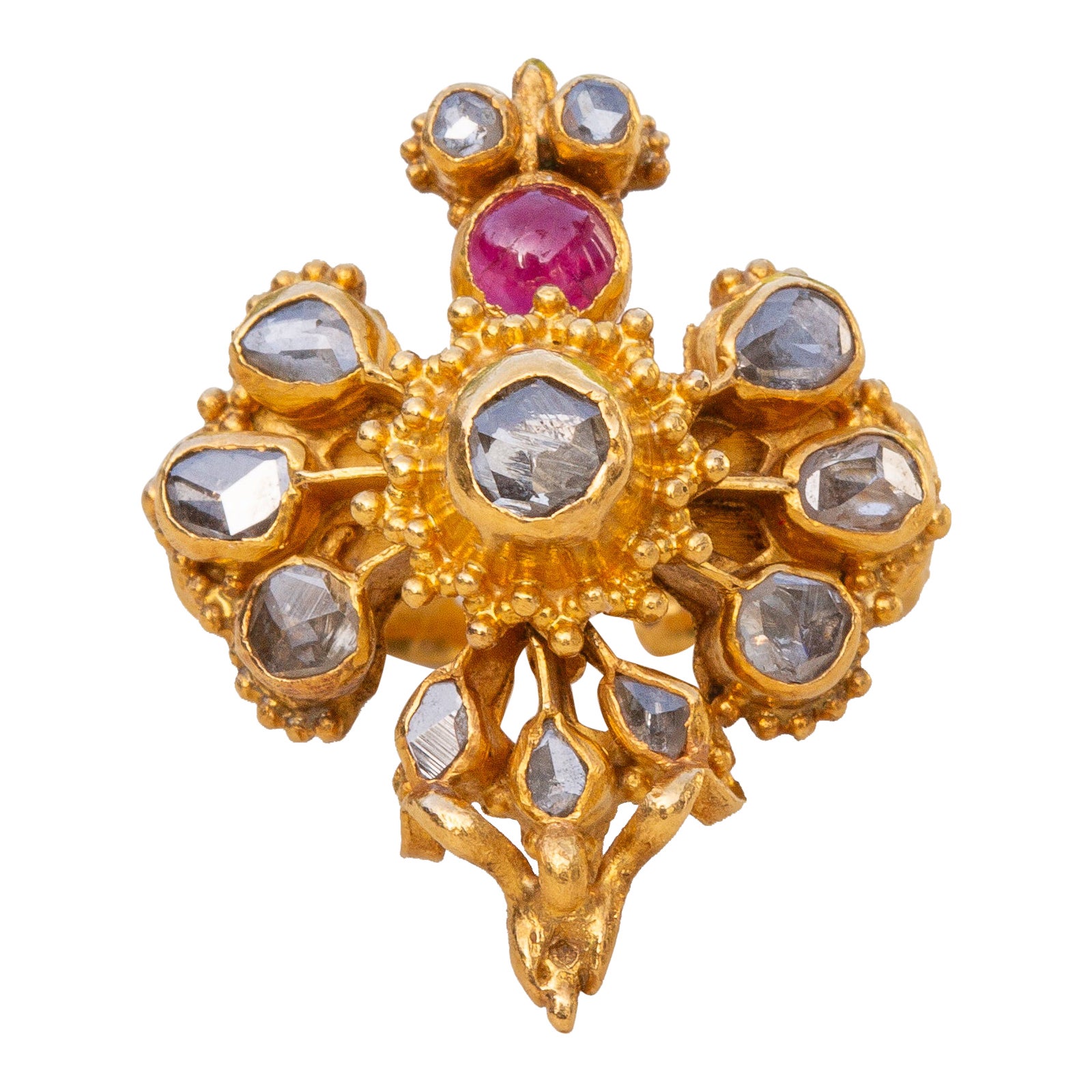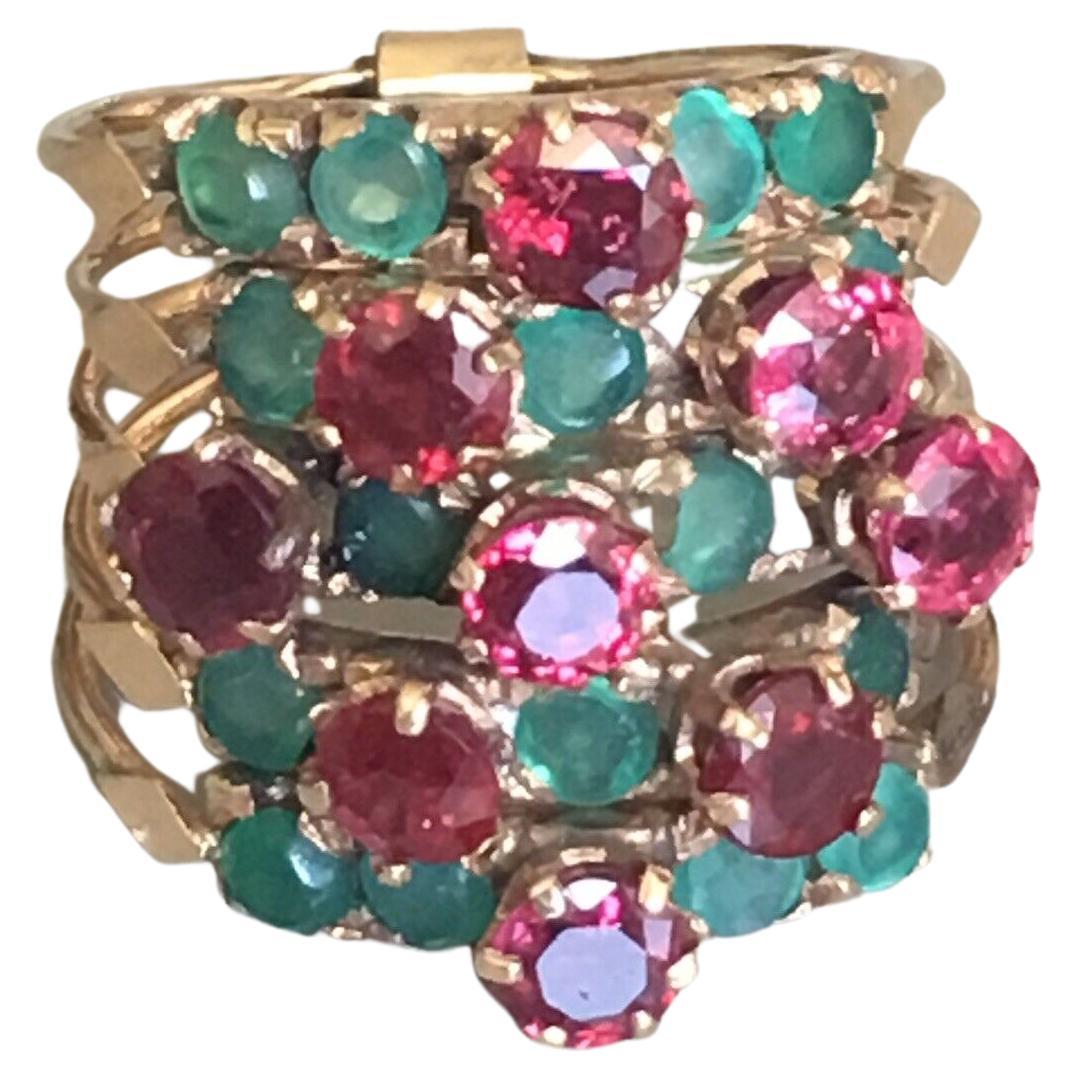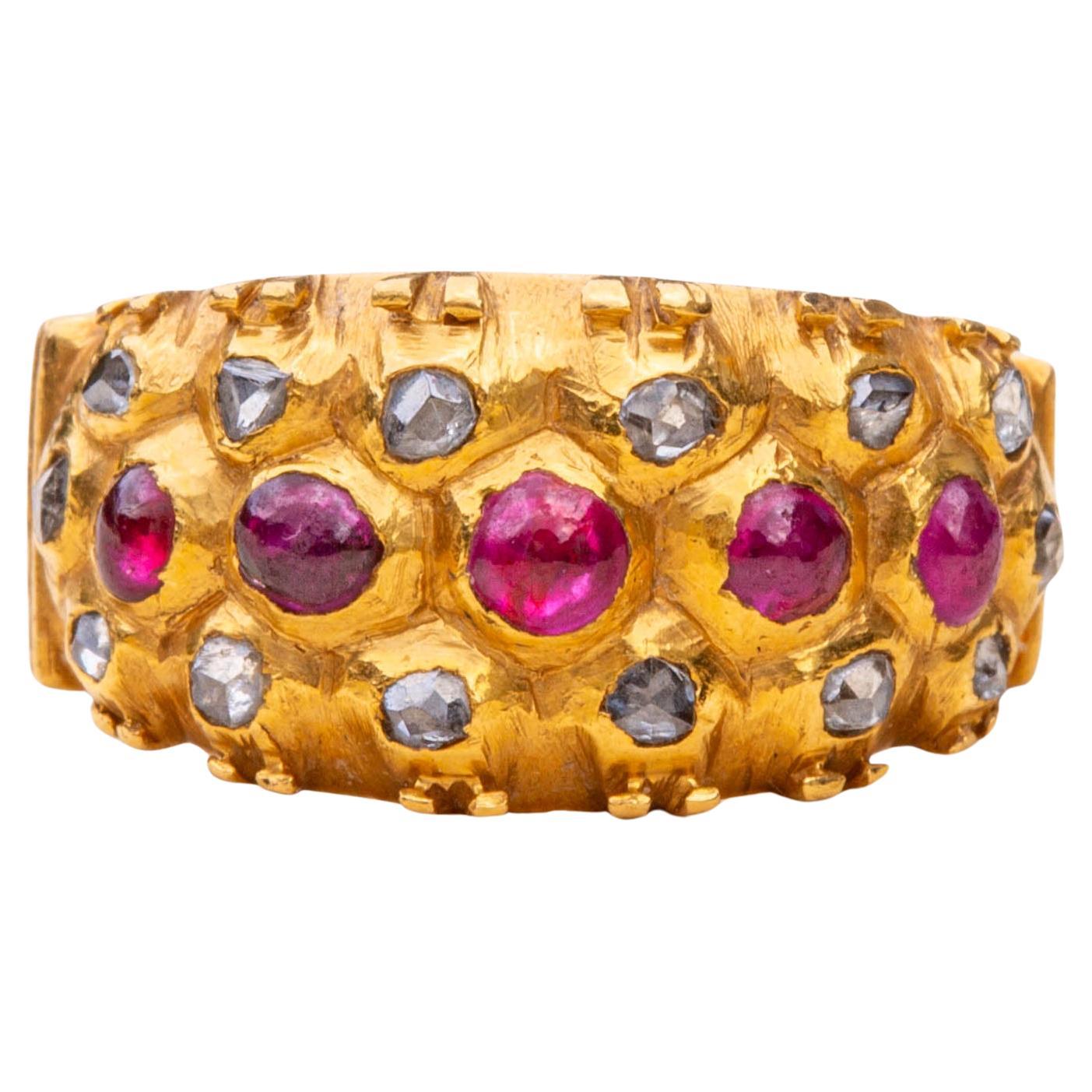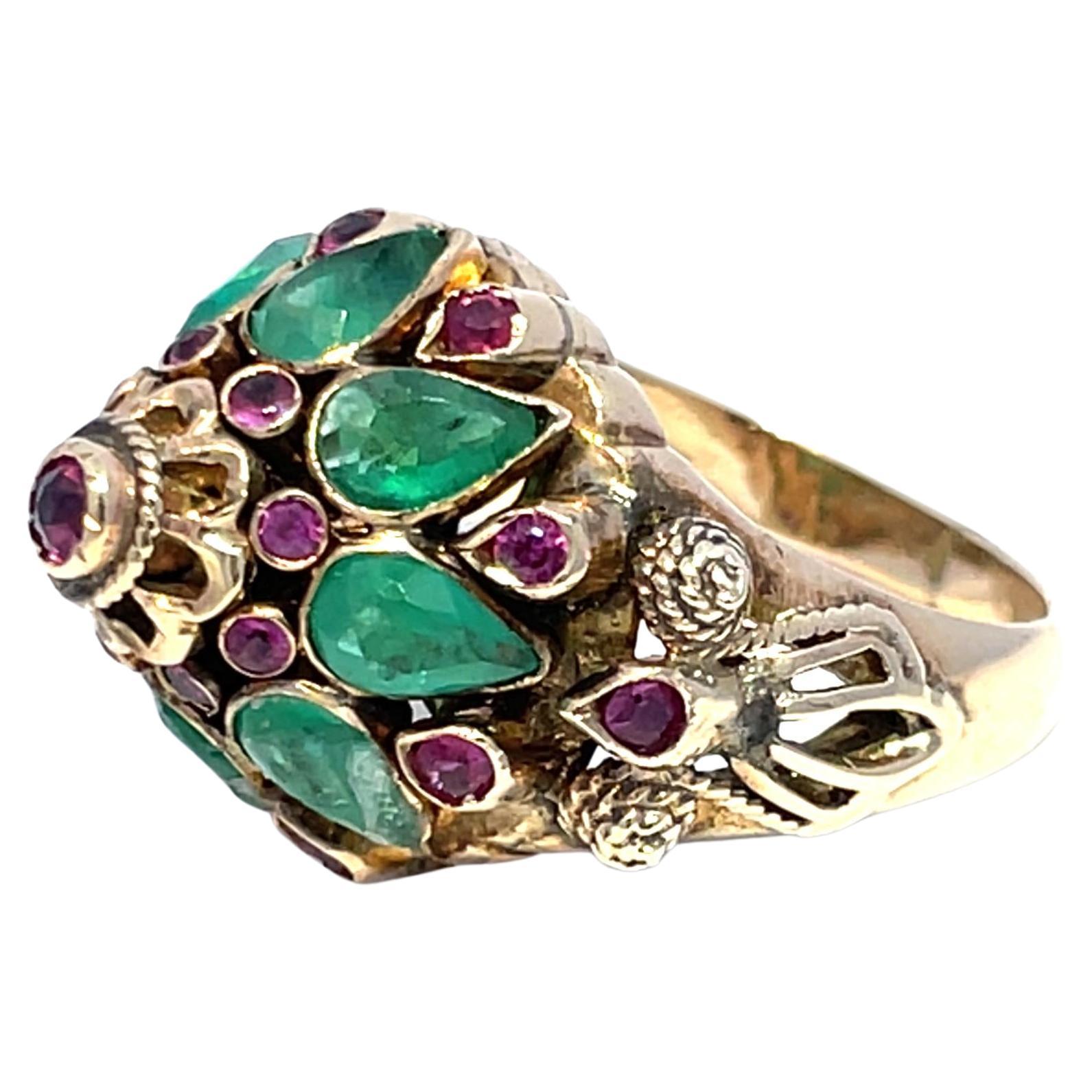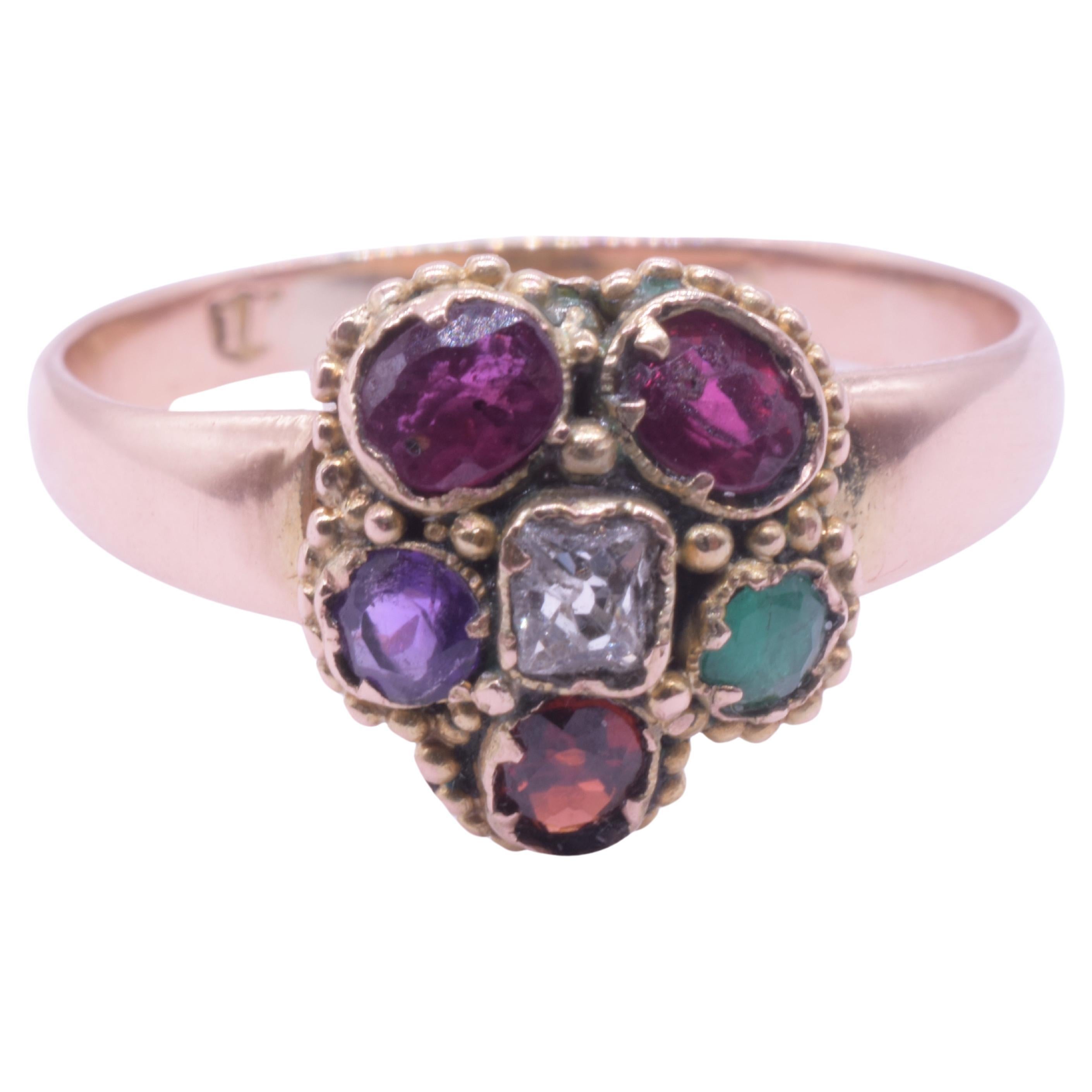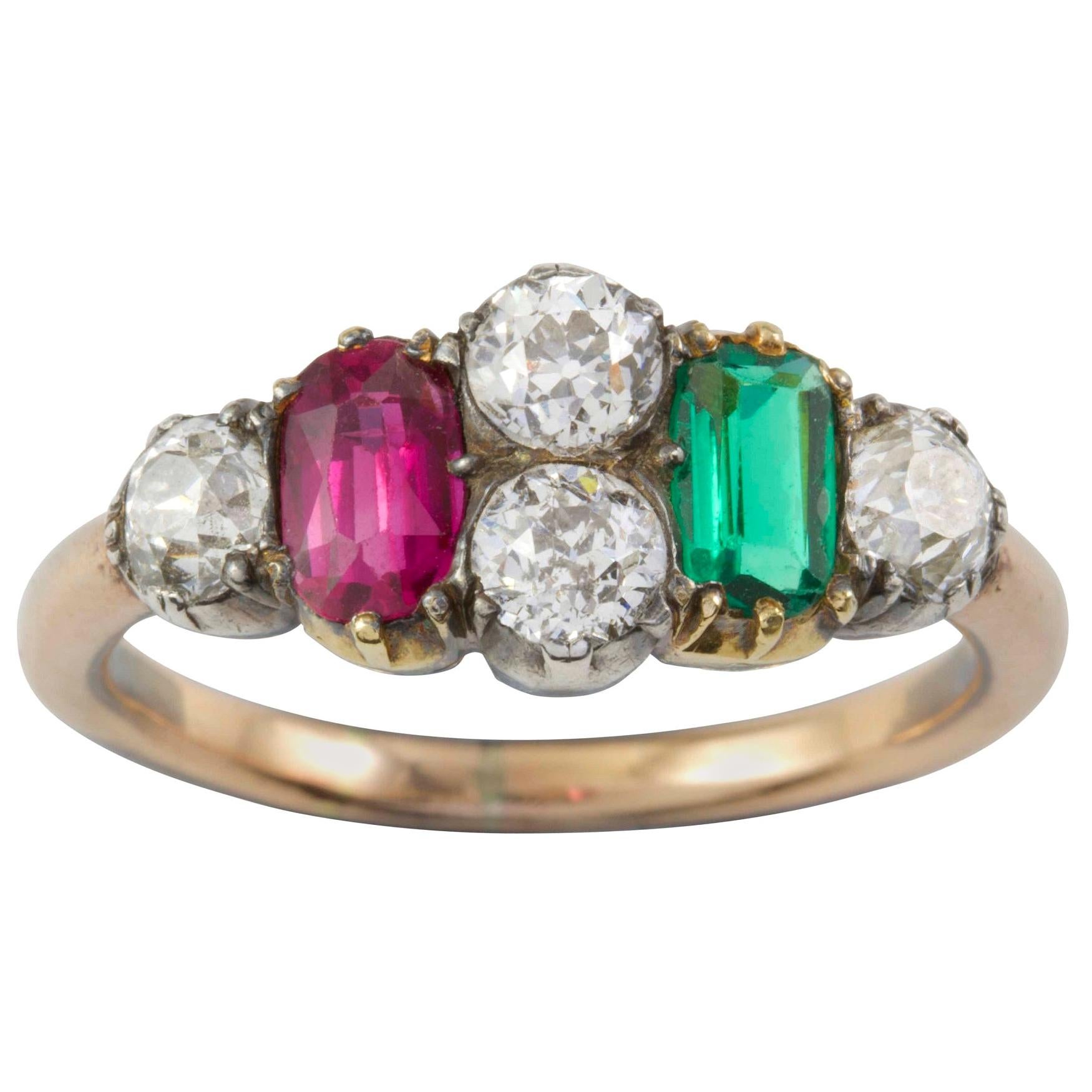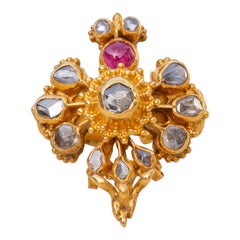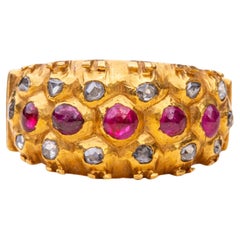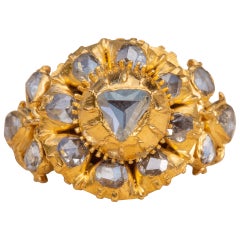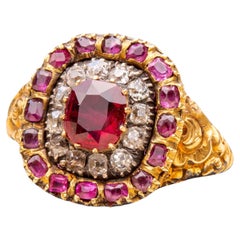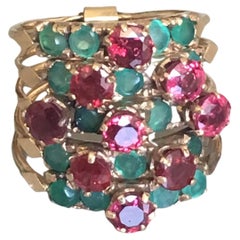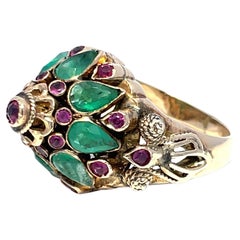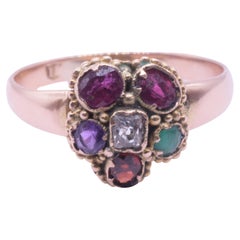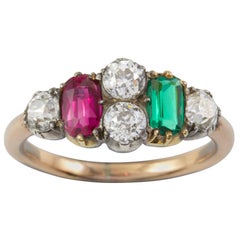Items Similar to Antique Thai Siam 19th Century Gold Princely Gem-Set Cluster Ring Ruby Emerald
Want more images or videos?
Request additional images or videos from the seller
1 of 16
Antique Thai Siam 19th Century Gold Princely Gem-Set Cluster Ring Ruby Emerald
$5,854.41
£4,250
€5,009.98
CA$8,050.70
A$8,953.15
CHF 4,686.56
MX$109,217.60
NOK 58,888.37
SEK 55,392.12
DKK 37,396.24
About the Item
A rare late 19th century gem-set princely gold cluster ring made in Siam (Thailand).
This gorgeous and colourful gem-set cluster ring is intricately crafted in high-karat gold, by the goldsmiths of the Siam court in the 19th century. The centre features a rose cut diamond in a rubber gold setting which is riveted to the body of the ring which is visible from the underside, a feature typical of 18th and 19th century Siam rings . It is surrounded by a halo of rubies, garnets and diamonds, with emeralds on the shoulders. The thick gold band features pierced scrollwork motifs and is stamped with a French gold import mark from when it was later brought into the country.
This ring is a fine example of the lavish adornment worn by participants in royal and aristocratic life-cycle ceremonies in the courts of Bangkok. Aside from ceremonial use, they were also occasionally given as gifts to important visitors or other aristocratic families. Examples of these lavish jewels being worn can be seen on old photos and paintings of life-cycle ceremonies such as the Royal Tonsure Ceremony, also known as ‘the cutting of the top-knot’ ceremony, which marked the transition into adulthood for all of the (many!) sons and daughters of the Siam royal family. The huge expansion in the number of royals in 19th century Siam stemmed from Kings Mongkut (Rama IV) and Chulalongkorn (Rama V) being highly polygamous. They had a joint total of 124 wives and 159 royal children, each requiring their own ceremonial regalia and princely jewels. As a result, Bangkok became home to some incredibly skilled goldsmiths in this period.
The ring is in good and wearable condition, there is evidence of a historic resizing at the back of the band, and two of the stones appear two be later replacements.
It tests as solid 21K gold and weighs an impressive 12.93 grams in total.
Size: UK size L 1/2, US size 6
About the Seller
5.0
Vetted Professional Seller
Every seller passes strict standards for authenticity and reliability
Established in 2019
1stDibs seller since 2022
46 sales on 1stDibs
- ShippingRetrieving quote...Shipping from: London, United Kingdom
- Return Policy
Authenticity Guarantee
In the unlikely event there’s an issue with an item’s authenticity, contact us within 1 year for a full refund. DetailsMoney-Back Guarantee
If your item is not as described, is damaged in transit, or does not arrive, contact us within 7 days for a full refund. Details24-Hour Cancellation
You have a 24-hour grace period in which to reconsider your purchase, with no questions asked.Vetted Professional Sellers
Our world-class sellers must adhere to strict standards for service and quality, maintaining the integrity of our listings.Price-Match Guarantee
If you find that a seller listed the same item for a lower price elsewhere, we’ll match it.Trusted Global Delivery
Our best-in-class carrier network provides specialized shipping options worldwide, including custom delivery.More From This Seller
View AllAntique Thai Siam 19th Century Gold Rose Cut Diamond and Ruby Garuda Bird Ring
Located in London, GB
A rare late 19th century gem-set princely gold ring made in Siam (Thailand). The ring takes the form of a mythical winged bird, possibly the Gar...
Category
Antique 19th Century Thai Cluster Rings
Materials
Diamond, Ruby, Gold
Royal 19th Century Siam Diamond and Ruby Ring
Located in London, GB
A rare 19th century princely gold cluster ring made in Siam (Thailand), circa 1860.This gorgeous ruby and diamond ring was intricately crafted in high-karat gold, by the goldsmiths of the royal Siam court in the 19th century.
It is a fine example of the lavish adornment worn by participants in royal and aristocratic life-cycle ceremonies in the courts of Bangkok. Aside from ceremonial use, they were also occasionally given as gifts to important visitors or other aristocratic families.
There was a huge expansion in the number of royals in 19th century Siam which stemmed from Kings Mongkut (Rama IV) and Chulalongkorn (Rama V) being highly polygamous. They had a joint total of 124 wives and 159 royal children, each requiring their own ceremonial regalia and princely jewels. As a result, Bangkok became home to some incredibly skilled goldsmiths in this period and the sheer number of jewellery required has meant that today princely jewels like this one can very occasionally be found in the open market, particularly in Europe following the relocation of the Thai royal family to Switzerland and France in the 1930’s and 1940’s.
The ring features a row of cabochon rubies horizontally aligned, surrounded by a sea of rose cut diamonds. All of the stones are in rubover settings within a web of hexagonal honeycomb frames. The band is decorated with pierced and deeply chased scrollwork motifs, typical of Siam jewellery...
Category
Antique Mid-19th Century Thai Band Rings
Materials
Diamond, Ruby, 22k Gold
Important 19th Century Royal Siam Diamond Cluster Ring Museum-Grade Thai
Located in London, GB
An outstandingly rare mid-19th century royal Siam diamond cluster ring, made by the royal goldsmiths of the court of Bangkok.
This is an extremely fine example of the jewellery commissioned and subsequently bestowed by the Kings of Siam, principally to be worn by participants in royal and aristocratic life-cycle ceremonies in the courts of Bangkok. In the mid-19th century, King Mongkut (Rama IV) of Siam also commissioned the courtly jewellers to create a number of faithful replicas of these ceremonial jewels to be offered as gifts to diplomatic families, important visitors and to Heads of State across the world when re-establishing diplomatic relationships. One such example (which is remarkably similar to the present ring) resides in the museum of the Château de Fontainebleau (item F1518C) where it was given as a gift from King Mongkut to Napoléon-III on the important ambassadorial visit of 1861 (see photos for a side by side comparison).
Ceremonial Use:
During the 19th century, many rings were made every year by the royal jewellers for ceremonial use. Examples of these lavish cluster rings being worn for these life-cycle ceremonies can be seen on old photos and paintings of the Royal Tonsure Ceremony, also known as ‘the cutting of the top-knot’ ceremony, which marked the transition from childhood into adulthood for all of the (many!) sons and daughters of the Siam royal family.
The huge expansion in the number of royals in 19th century Siam stemmed from Kings Mongkut (Rama IV) and Chulalongkorn (Rama V) being highly polygamous. They had a joint total of 124 wives and 159 royal children, each requiring their own ceremonial regalia and princely jewels. As a result, Bangkok became home to some incredibly skilled goldsmiths in this period. The Tonsure ceremony was performed by the King, and lasted three days and three nights. All of the royal children would be dressed in the most splendid costumes and adorned with a vast amount of jewels on several parts of the body. Their costumes and jewels differed according to their title and rank. Diamonds for instance, would be bestowed to the highest ranking noble children. The royal children were allowed to keep their regalia and jewels as a present on entering adulthood to indicate their social status among society.
Over the years, these royal jewels have been dispersed across the many noble families, with currently only a few important pieces remaining in the royal collection. Today, the number of royals in Thailand is contracting as the country follows the Chinese nobility system whereby with each generation the noble rank of a family decreases by one ranking so that eventually the majority of descendants will lose their noble status completely. This loss of royal privilege, coupled with the dilution of wealth has meant that items such as this ring become available on the open market. Following the end of the absolute monarchy in Thailand in 1932, many members of the royal family relocated to Europe and as a consequence, princely Thai items can occasionally be found in the European art market.
Gift Exchange:
In Siam culture, great importance is placed on the ancestral process of gift-exchange. During the reign of King Mongkut, close relationships with some powerful countries were cultivated in order to hold the balance of power and to save Siam from being colonised. The King used gift-exchange to establish diplomatic relations with other heads of state around the world, as well as with other kings, princes and sultans closer to home. He sent troupes of ambassadors to England (1857) and France (1861) with seemingly endless amounts of trunks filled with lavish gifts in order to dazzle the heads of state with the extraordinary quality and variety of Siam craftsmanship.
These gifts consisted of faithful replicas of the Royal Regalia and objects belonging to the King himself; items and jewellery worn by him on his Tonsure ceremony and on his coronation day. Enormous time and effort was required by the Siam court to assemble these numerous gifts, as they emanated from the very same royal goldsmiths and courtly craftsman who had made the original ceremonial items.
The most famous of these ceremonies took place at the Chateau de Fontainebleau in 1861. The painting by Jean-Léon Gérôme that immortalised the event prominently features the most spectacular of these gifts. Among the 150 gifts presented to Napoléon-III by the Siam ambassadors were two diamond-set rings, both of which are on display in the Musée du Chateau de Fontainebleau (item no. F1518C and F1519C). One of these rings is a rose cut diamond cluster and bears a striking resemblance to the ring we are offering. According to Bruley (2011), this ring, presented to Napoleon-III, was a faithful replica of the ring worn by King Mongkut on his own coronation day in 1851, which now resides in the Pavilion of Royal Regalia in Thailand.
The Ring:
From whichever angle the present ring is viewed, it is a masterpiece of design and a testament to the ingenuity and craftsmanship of the Siam royal goldsmiths. The bezel head is composed of two layers, the uppermost, containing the large triangle shaped table-cut diamond, is riveted to the main body of the ring. The second layer of the cluster is set with a further eight rose cut diamonds and this section allows for small rotation, typical of Siam jewellery...
Category
Antique Mid-19th Century Thai Victorian Cluster Rings
Materials
Diamond, 22k Gold
Antique Georgian Early 19th Century 1ct Ruby and Diamond Target Cluster Ring
Located in London, GB
A superb antique Georgian ruby and diamond ring made in England, circa 1820. The centre of this ‘target’ shaped cluster ring is set with a 1ct cushion cut deep red ‘pigeon’s blood’ r...
Category
Antique Early 19th Century English Georgian Cluster Rings
Materials
Diamond, Ruby, 22k Gold
Antique Gold Indonesian Bali Garnet Ring 19th Century Hummingbird Gold Ring
Located in London, GB
A scarce late 19th century gold ‘priest’s ring’ from the island of Bali, Indonesia.
The ring is a fantastic example of the southern Balinese style, where ...
Category
Antique Late 19th Century Engagement Rings
Materials
Gold
Antique Indian Gold Ruby Cabochon Ring Mughal Period
Located in London, GB
A scarce late Mughal period Indian gold and ruby ring dating from the mid-19th century.
The cabochon cut ruby is belcher set in an open-backed mount and weighs approximately 1ct. Th...
Category
Antique Mid-19th Century Indian Late Victorian Engagement Rings
Materials
Ruby, Gold, 22k Gold
You May Also Like
Victorian Burmese Ruby & Emerald circa 1880s Signed Gold Antique Multi Band Ring
Located in Los Angeles, CA
Victorian hallmarked circa 1880s gold Antique Multi Band ring
Burmese Ruby & Emerald
9 pieces of 4 mm natural round Burmese Rubies and 16 pieces of ro...
Category
Antique 1880s Victorian Cluster Rings
Materials
Emerald, Ruby, Gold
Vintage 14k Yellow Gold Emerald and Pink Sapphire Harem Ring
Located in New York, NY
Discover the exquisite charm of our Vintage Thai Princess Harem Ring, a stunning piece that embodies the elegance of a bygone era. Crafted from luxurious 14k yellow gold, this antiqu...
Category
Antique 19th Century Cluster Rings
Materials
Emerald, Pink Sapphire, 14k Gold, Yellow Gold
C.1860 15K REGARD Flower Ring w Ruby, Emerald, Garnet, Amethyst, Ruby, Diam
Located in Baltimore, MD
This circa 1860 15K early Victorian Regard ring with 5 stones set in radially around the face in a forget-me-not, the first letter of which spell out ...
Category
Antique 19th Century European Victorian Cluster Rings
Materials
18k Gold
Early Victorian Ruby, Emerald and Diamond Ring
Located in London, GB
An early Victorian ruby, emerald and diamond ring, to the centre two old brilliant-cut diamonds estimated to weigh 0.5 carats in total, set between an emerald estimated to weigh 0.3...
Category
Antique 1840s British Early Victorian Cluster Rings
Materials
Diamond, Emerald, Ruby, Yellow Gold, Silver
Antique Victoria Era 14k Gold Ruby Sapphire & Tourmaline Ring
Located in Montreal, QC
Antique Victorian era 14k yellow and white gold ladies ring, stamped 14k. Set with 19 round shaped, mixed cut natural rubies, 8 pear shaped cabochon gemstones. Composed of citrine, t...
Category
Antique 1880s Unknown Victorian Cluster Rings
Materials
Ruby, Sapphire, Tourmaline, 14k Gold
Vintage Indian Kundan 18K Gold Ring with 1ct Ruby and 1.8ct Rose-Cut Diamonds
Located in Miami, FL
A regal and richly detailed vintage Indian ring, handcrafted in 18 karat yellow gold in the traditional Kundan style. The bold, domed silhouette is adorned with intricate hand-engrav...
Category
Mid-20th Century Indian Revival Band Rings
Materials
Diamond, Ruby, 18k Gold, Yellow Gold
More Ways To Browse
Gold Thai
Antique Siam
Antique Royal Rings
1860 Gold Ring
21k Gold
Antique French Emerald Ring
19th Century Emerald Ring
18th Century French Jewelry
18th Century Emerald
21k Gold Set
Kings Court
Huge Emerald Ring
18th Century Ruby
Emerald Ruby Antique Ring
Antique Thai Ruby Ring
21k Gold Ring
18th Century Ruby Ring
18th Century French Ring
